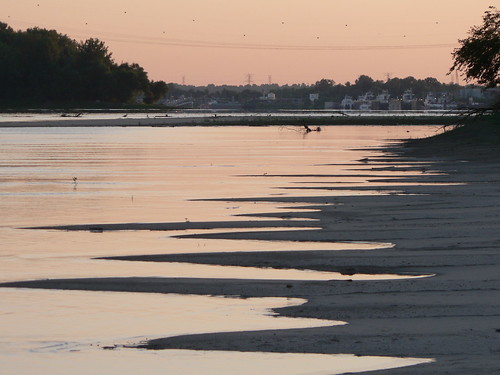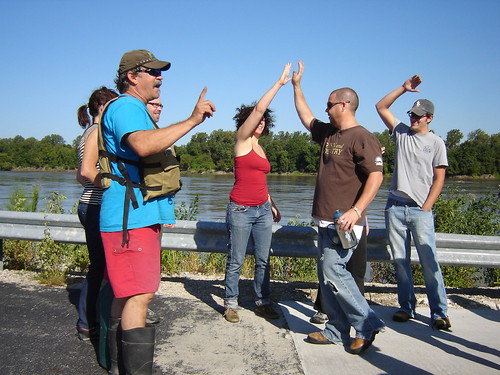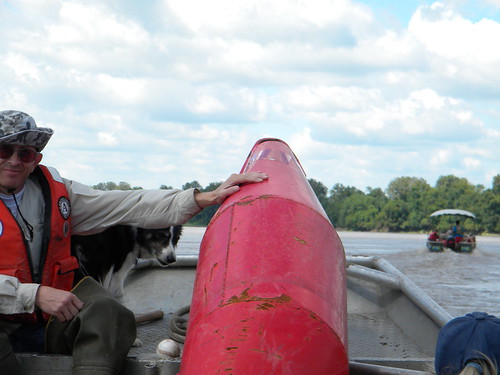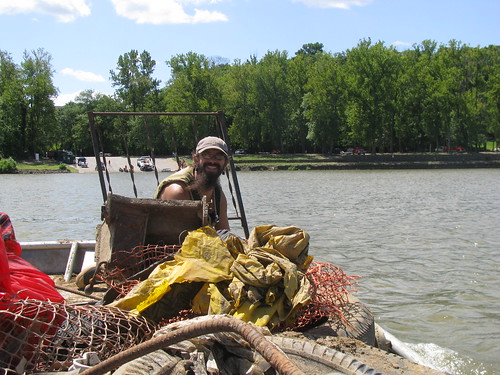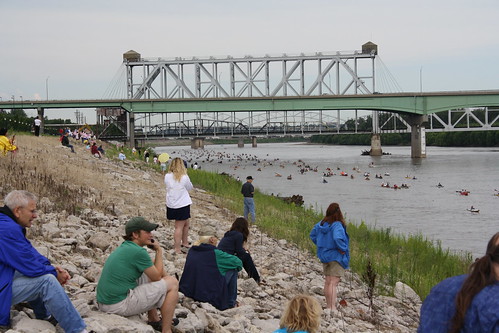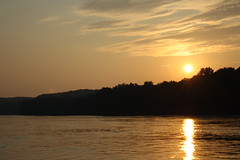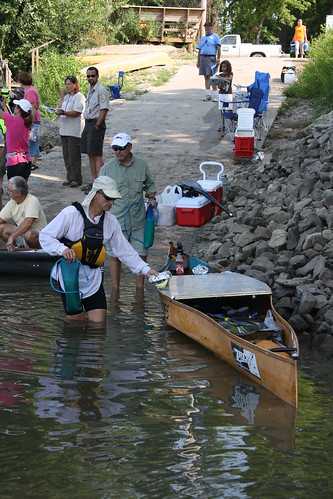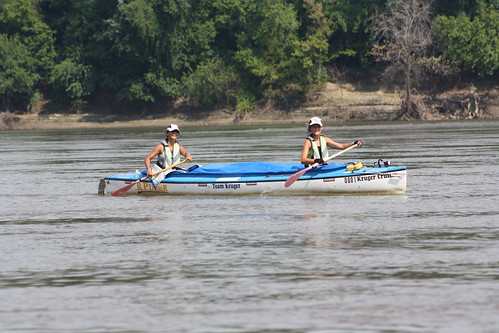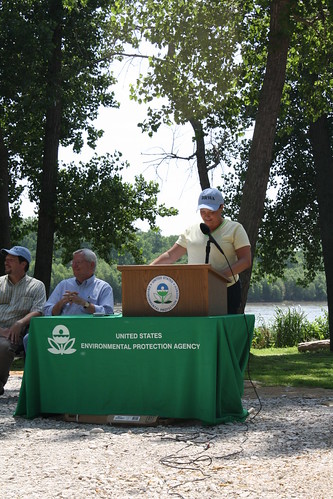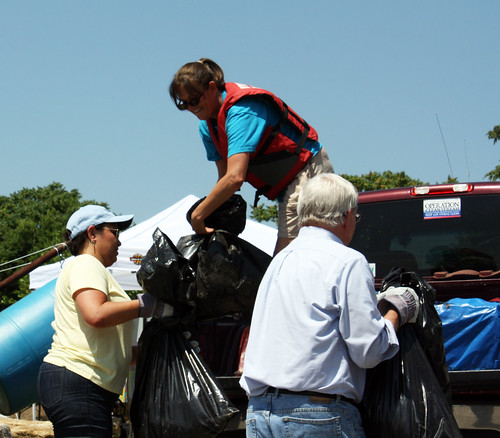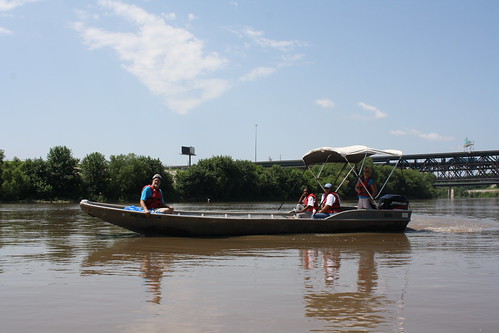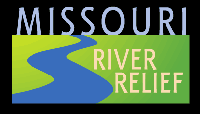Missouri River 340 - 2008
Kaw Point Park (KC) to Lewis and Clark Boathouse (St. Charles)
July 15 - 19, 2008
text by John Brady, photos by Dylan Lehrbaum
Blogmaster's note: Missouri River Relief Quartermaster John Brady gave this to me during the winter, and I just never got around to posting it. Sorry John! But here it is, in anticipation of this week's fourth annual Missouri River 340. I have just had the privilege of participating in my first MR 340 paddling race across Missouri. Not as a contestant, mind you, as I have no experience at that type of thing. No, I was a crew member on one of Missouri River Relief”s safety boats that escorted the racers from Kaw Point to St. Charles. I learned a lot last week, both about the race and the racers and about human spirit.
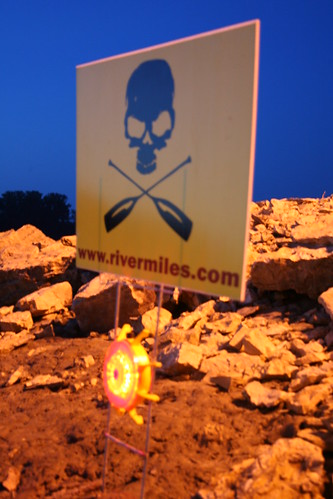 Monday:
Monday:The highlight was Scott Mansker’s safety meeting. I was warned that he is pretty good with a word and his presentation to the full house of excited contestants and support crew conveyed all that could reasonably be expected to be absorbed about the river and the race as well as allaying the anxieties of the novices and the support crews. What a varied audience he had there! It was apparent from his talk that he had pared it down to the essentials, that he knew his subject very well and that he had great concern that all participants had a grasp of what they would need to know at a minimum.
Day One:Kaw Point was a circus. From an early rise to get our chase boat ready to go, we onlookers were presented with a real spectacle. Every kind of paddle boat from sleek six-man racing kayaks to dented outfitter-surplus aluminum canoes were on hand. The racers and their crews were as varied as the boats. From tie-dyed straw hatted hipsters dragging beat-up boats to a likely launch spot to compression-suited warriors marching their sleek craft to the ramp in lockstep, the whole spectrum was assembled.
The flailing madness of the mass start was simply astonishing. Sprinters and slow-movers frothing the water of the Kaw to a fair-thee-well was a scene unique in the universe I think. The lead team canoes and kayaks flew along and were soon out of sight, leaving a river full of boats snaking down the channel in a mass of flashing paddles against the best view ever of Kansas City’s skyline.
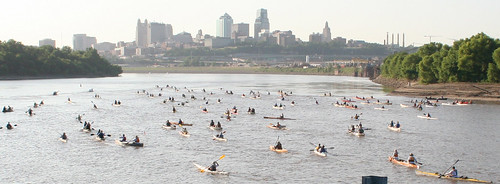
At Miami, we were asked to hurry downriver to find and escort a commercial barge tow up through the paddlers during the night. I was concerned that this would run us short of fuel and went about in the crowd inquiring about securing some more fuel. The mayor of Miami was there cooking hot dogs and welcoming racers and crew. He said he would be glad to get me some fuel in Marshall, MO., 15 miles away. I got my empty tank out of the boat and gave it to him. He turned to put it in his truck without a word. The guy didn’t even ask about the money for the 12 gallons of gas. At $4.00 a gallon! I gave him the required money and the next morning, as arranged, he had the fuel, the change to the penny and a receipt back at the ramp. That doesn’t happen everywhere to be sure.
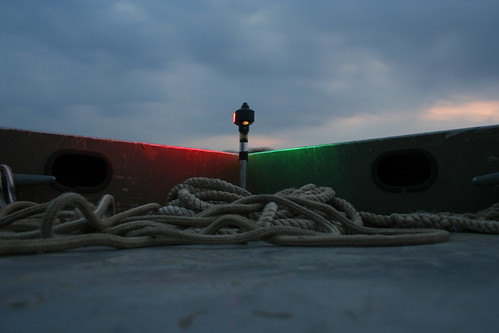
The night cruise down to Glasgow was one of the best runs I’ve had in years. Full moon high, glassy water, paddlers going by seen simply as tiny lights on the water; the effect was spiritual in a high degree.
Day Two:After a 2:00 a.m. arrival at Glasgow, we were asked to lay over until the morning. We secured the boat and my crew members turned to the sod at Stump Island Park to attempt some rest. I wandered up to the top of the ramp where I encountered Scott’s dad, obviously deeply sleep-deprived, worrying about near-overdue paddlers, the rush to his next check point and the race logs. I was impressed how important it was to the race organizers that the record of contestant’s arrival and departures be kept accurately and get to the finish before the first competitor arrived there.
Scattered pods of paddler zombies wandered by, arriving, departing, slamming fuel, taping and medicating- all in all a supercharged Dante’s Inferno of racers and supporters empathizing with the sheer weight of what the racers were enduring.

I finally crashed in the boat under a rough tarp with a PFD for a pillow. Nothing could have felt better. Toward dawn I woke up as an intense solo kayaker slipped her craft into the water. Barely revived, she ghosted into the misty river. I talked a bit to her mom, there as her support team. She related that she had awakened her daughter at the designated time with the words “Honey, it’s time. Are you ready?” To which her daughter sleepily replied, “Mom, I was born ready!” and hopped up, indeed ready to rumble again. I was told later that this was Katie Pffeferkorn, the racer that won the women’s solo class.
Our chase boat was told to stand by there until further instructions. Too excited by what I was witnessing to rest further, I ambled uptown, got a plate of crepes (yeah, in Glasgow) and trailed back to the park.
Shortly, we got instructions to high-tail it down to Cooper’s Landing in search of a towboat thought to be heading up into the rough river below Glasgow. Soon we learned that the tow in question had already transited the area (we had passed her tied up late the night before) and we headed down to Cooper’s Landing and assist with the checkpoint there.
What a great afternoon voyage we had! Winding our way down through the infamous Jameson Island country, slowing near the paddlers and then letting the boat stretch out a bit, we landed at Cooper’s at around 4 p.m. We tied up and my crew melted into the scene. They had boats to pick up and move the next day and were to man a section downriver after that. I am still amazed at the delicate dance we did to make this escort thing work out with available crew and machinery.
At Cooper’s, we attempted to get some sort of light out on a submerged dike which was making it difficult for paddlers to land. There followed a Keystone Cop sort of affair that, while ending successfully, involved placing a light on the underwater dike while avoiding approaching racers. I was able to adroitly complete the tricky task by momentarily getting the boat hung up on the dike and then successfully colliding with a pontoon boat moored above it.
Oh Yes! This happened at my home port with a large audience, many of whom know me. At least they used to admit to doing so.
I spent the night snug in my van (remember Chris Farley on SNL?-“Let me get this straight. You’re living in a van, down by the river?”) Sometime in the night I was awakened by a nearby voice, plaintive and drunken, exclaiming over and over “ All I want to do is take off my clothes and jump in the river!” When I could stand it no more, I selfishly opened the window and yelled “Go ahead! Jump!” My sentiment was echoed by at least one neighbor and put an end to the drama.
Day ThreeI spent the day on R and R, maintaining a communication station for the chase boats and shepherding a succession of paddlers that I knew into my van to rest or into a nearby cabin. During mid-afternoon, my replacement crew mates arrived, bringing coolers full of unbelievably great sustenance, along with fresh vigor, to the process. I had already cleaned and serviced the boat. We were asked to follow the last racers (arrived a few hours earlier) downriver.
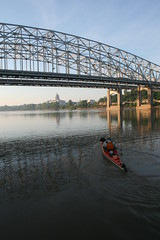
We left several hours before sundown, running sweep after two very tired and very game young first time racers. Along with another escort, we headed to Jefferson City, landed and quickly departed down again. Again, the night run was awesome. The river was up over the dikes, the full moon made navigation a breeze and the pace set by the last paddlers was leisurely and peaceful.
In order to not outrun our charges, it was necessary for us to motor for a bit and then shut down the machinery and just float for a while. Gliding along, under a gorgeous moon in near complete stillness was a pleasure beyond price and beyond my ability to describe.
Having never run this stretch at night before, I was alert and paid attention to the task. It was all cake until around ten p.m. when a mist began to form on the water. Sometimes it was barely there and sometimes almost a shut out. We were able to take it in stride and relax, though. The only problem was the pace.

The team we were following, running on fumes of awareness, was zig-zagging back and forth across the river to get a real close up visual on EVERY day board so they wouldn’t get lost, crossing back and forth from one side of the river to the other and going far more distance than they needed to. You had to admire their grit if not their technique.
We made landing at Chamois, not a checkpoint but where the two paddlers had support people (Mom and brothers and sis) waiting. On the approach to the ramp, we were on the phone with Scott, who was there tending the last of his flock. I was having trouble in the mist picking the landing ramp out from all of the lights at the power plant just below and asked Scott to show a light if he could. He switched on a spotlight so powerful that I swear it burned through the back of my retinas. Man, what a beam!
The racers decided to rest a bit so we walked up to the adjacent park to sleep under the pavilion to ward off the dew. We needn’t have bothered. The mosquitoes were so thick that the dew couldn’t have found us using Scott’s mega-light. I swear, it was the softest gravel I ever laid a tired body down on.
Day FourWe got up before dawn and downed coffee, cake and sardines with mustard. (It really didn’t seem that strange at the time). Wow. Fresh, hot coffee, courtesy of our accompanying houseboat. Thanks, Jack. We ambled down past Washington, a former checkpoint that was abandoned due to high water making the approach to the ramp really hard for the unaware. Stopped and got-DONUTS!!
Our weary paddlers soon slipped back into their zig-zag pattern of navigation. We joked about it a little but had to admire their never-say-die spirit. At times their strokes were in perfect union but their paddles barely dipped in the water and their strokes were but a foot long. Running on the autonomous nerves I guess.
We went by Herman and into a hot and breezy afternoon. The country down, there, from Herman through St. Albans is my second most favorite scenery on the middle reach of the Missouri River. Through the Berger Bottoms (the locals use a “soft” G) where another of our boats had a rough encounter with a box dike the night before. “Pride goeth”, as they say.
Long, long reaches which were lengthened further by the slow wayward path we followed. In late afternoon we landed at the last checkpoint, I believe called Weldon Springs. There we met up with some of our forward contingent of chase boat crew that had been manning the post and combating the “skeeters” since last night.
Impressed with our lamentatious account of the meandering progress of the day (embellished to just the right degree) they graciously directed us to speed on ahead to the finish line on some probably unnecessary task, knowing that there was refreshment and enjoyment to be had there.
As there were no other paddlers between that point and very near the finish line, we went ripping down the river at max motion, theoretically gaining back every hour in twenty or so miles that we had lost in the previous 320.
After slowing briefly just above the finish to allow the second and third to last racers to cross the line, we landed at St. Charles just after the awards ceremony. As I walked up the bank to the bonfire, Scott’s dad once again appeared. “We have several cases of donated wine that we didn’t use in the awards dinner”, he said. “We’d like to give them to your group”. “Oh”, I nonchalantly replied. “You’ve heard of us, then”.
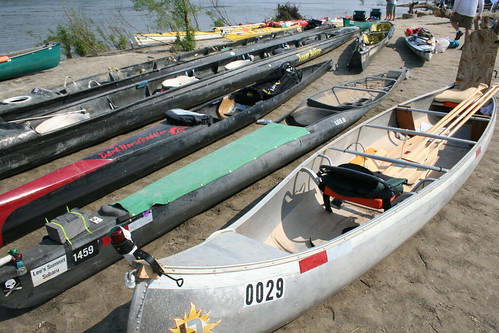 The wildest collection of race craft ever seen in St. Charles.
The wildest collection of race craft ever seen in St. Charles. Possibly the best part for me among many memorable scenes, was watching the last racers, our flock for many miles, finish the race. Down they came toward the finish line, paddling with renewed energy dredged up from God knows where. There to cheer them on, among tooting horns and screaming approval, was every, and I mean every, living soul still on the premises.
Hail Warriors!

